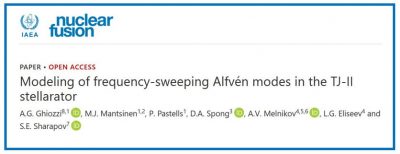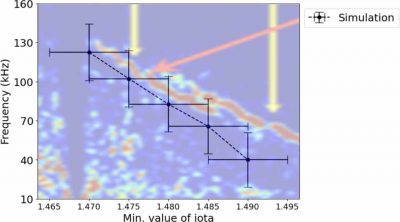
Alfvénic instabilities driven by energetic particles pose a challenge to the efficient operation of magnetic confinement fusion devices. These modes can dispel fast ions leading to the introduction of significant heat loads onto plasma facing components and degradation of overall plasma confinement. One class of Alfvénic instabilities known as reversed shear Alfvén eigenmodes (RSAEs) are of particular risk in devices with reversed shear rotational transform profiles. Reversed shear configurations have recently been of interest because of their enhancement to confinement quality. With this in mind, further study of RSAEs is necessary.
RSAEs, also called Alfvén cascades, were observed in the TJ-II flexible heliac in hydrogen plasma discharges with varying magnetic configurations. In our recent journal publication in Nuclear Fusion, we simulate the cascade events using the STELLGAP and AE3D codes and study the relationship between the frequency of the modes that form the cascade and the minimum value of the rotational transform profile. The simulations predict the appearance of a cascade sweeping downward in frequency formed by a set of modes with m (poloidal mode number) = 6, and n (toroidal mode number) = – 9 when the minimum value of the iota profile is varied between approximately 1.47 < imin < 1.50, which is corroborated by experiment. The results presented support the utility of MHD spectroscopy, a diagnostic tool whereby the temporal gradient of the frequency of an Alfven cascade can be used to determine the variation in time of the plasma’s rotational transform profile

The full journal paper written by our ex-group member Adriana Ghiozzi together with our group leader Mervi Mantsinen, ex-group member Pol Pastells and collaborators can be found at the following link: A.G. Ghiozzi et al 2024 Nucl. Fusion 64 036005.

